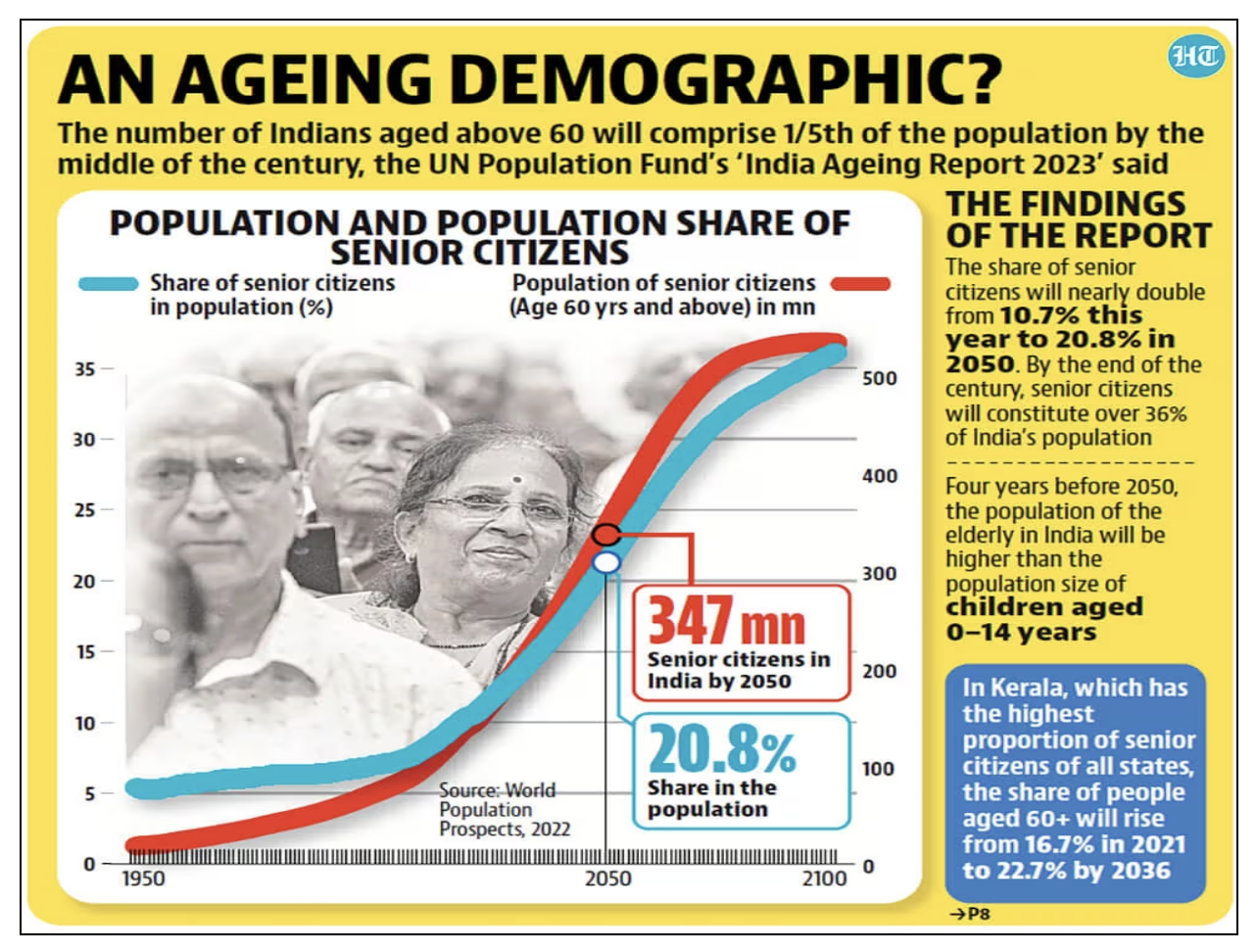An ageing India: The magnitude and the multitude
Relevance: GS Paper I
Why in News?
From social and financial independence to ensuring an active life course, we need to focus on preparatory measures for India’s ageing population.
More About News:
- The ageing phenomenon is a notable experience of this century with remarkable improvement in human longevity and the lowest levels of reproduction.
- In India, the four vulnerabilities of later ages are restrictions in activities of daily living, multi-morbidity, poverty, and absence of income.
- The Longitudinal Ageing Survey of India (LASI, 2017-18) reports that about 20% of the elderly population experience each of these vulnerabilities with widespread variation across the States.
- The remedial approach to address these vulnerabilities requires a multi-pronged approach that includes social security measures and principles of inclusion.
- Recognizing these vulnerabilities as a life course phenomenon, it is essential to promote life preparatory measures that ensure not only financial independence but also healthy, active, and productive years, especially given increased longevity.
Changing Household Dynamics, Projected Magnitude, and Characteristics:
- The increasing elderly population should not be viewed in isolation, as this demographic shift is happening alongside a transition in family structures.
- This familial transition is evident in the reduction of average household size, which must be considered about household compositions and how the elderly are accommodated within them.
- While there are households without elderly and households with multiple elderly, there are frequent instances of elderly living with elderly within the household.
- Not only is this living arrangement becoming more and more frequent but there are other features of dependence, care provisioning as well as social security and financial protection assuming prominence in households with elderly compared with those without them.
- This points to a persistence of vulnerabilities stated above in individual elderly arising simply out of the household features more than individual characteristics.

Contrasting Today's and Tomorrow's Elderly
- There may be advantages in education and economic independence but adversities in health and quality of living due to rising longevity and chronic ailments.
- The slogan of healthy aging should focus more on the prospective elderly rather than just the current elderly population.
- While limitations in daily activities (ADL) worsen with age among the elderly, there is hope that future elderly generations might experience these difficulties less intensely and at a later stage in life.
- Health promotional measures among late-age adults need particular emphasis to ensure healthy ageing in future that would facilitate mainstreaming the elderly population in multiple productive spheres of activities.
Health concerns and emerging issues among the elderly
- The projected elderly population is estimated at 319 million by mid-century, growing by around 3% a year, with a higher proportion of females and those living in rural areas.
- The most disturbing feature relates to the health status that is reported to be poor by a quarter of the elderly as against about 20% among the population aged 45 and above.
- This trend is not encouraging as more and more are experiencing poor health early in life.
- While 75% of the elderly population are victims of one or more chronic diseases and 40% of those aged 45 and above have one or the other disability, there is a burden that by all means needs to be brought down in the future.
- With the advent of the global burden of disease, it is apparent that the two threatening forces are diabetes and cancer which appear to be frequent among India’s elderly.
- The new emerging concern relates to mental health with 20% of those aged above 45 self-reporting some ailment, primarily associated with depression; this is reasonably higher compared with the self-reported extent among the elderly.
- Food insecurity is also a concern among India's elderly, with some eating smaller portions, skipping meals, or not eating despite hunger.
Awareness, Expectations, and the Need for Social Agency
- There is limited awareness about welfare provisioning, legal recourse (Maintenance and Welfare of Parents and Senior Citizens Act, 2007), and concessions for the elderly population in India.
- Expectations from life are very few among India's elderly, who face insecurities, vulnerabilities, and varied forms of abuse, particularly for women in rural areas.
- There is a need for creating social agency for this vulnerable group, innovative institutions, and a focus on ensuring an active life course for the future elderly.
Conclusion:
The ageing population in India faces significant vulnerabilities including health issues, economic challenges, and changing family dynamics. Addressing these concerns requires a holistic approach integrating social security measures, health promotion, and awareness initiatives tailored to the needs of the elderly. Efforts should focus on enhancing quality of life, reducing health disparities, and fostering inclusive environments to support healthy ageing and well-being in the future.


